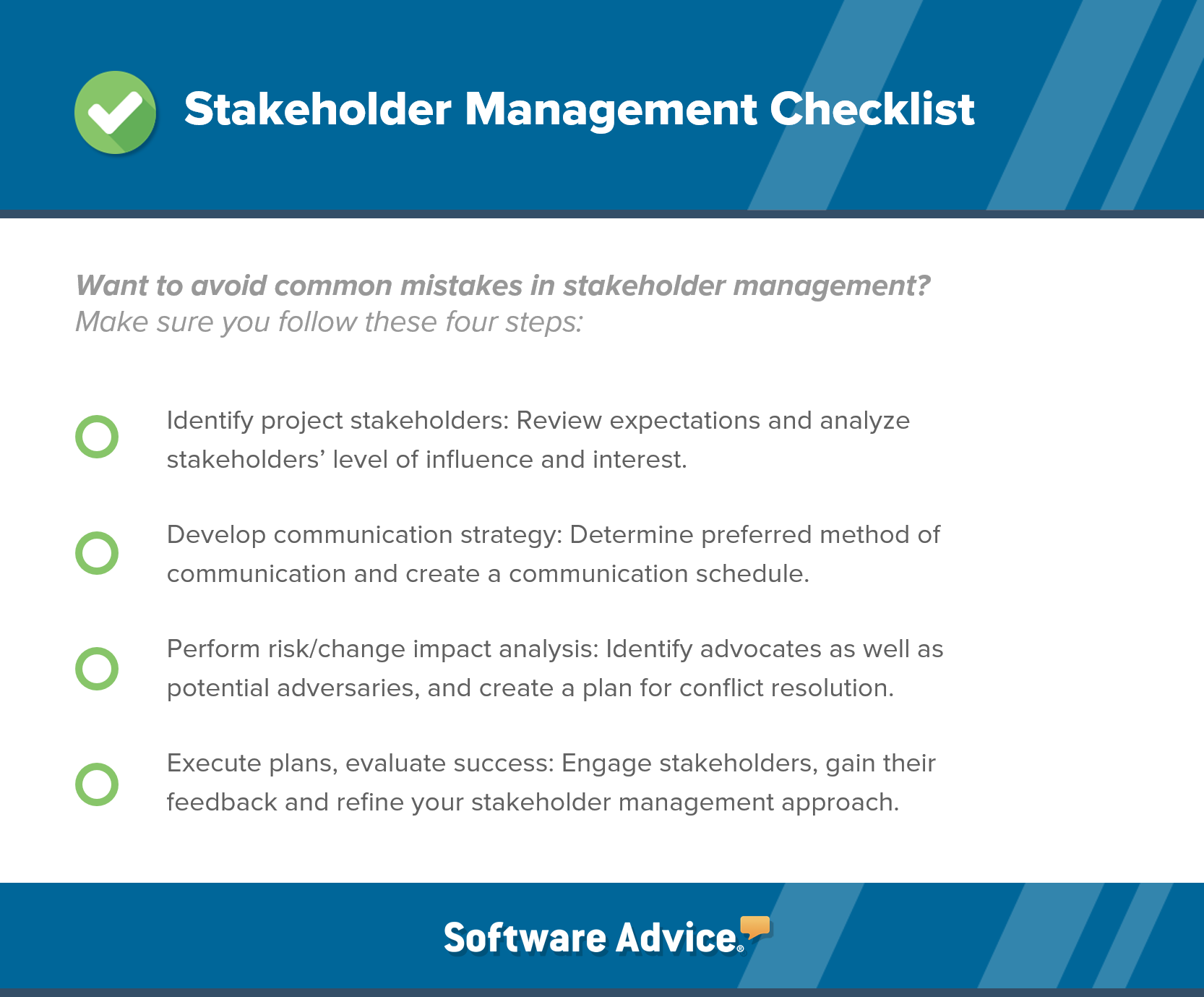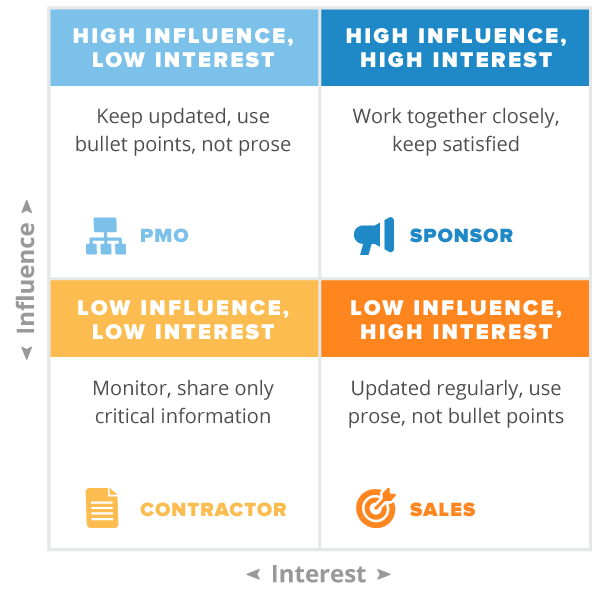How To Effectively Manage and Engage Project Stakeholders (Checklist)
“What are the biggest mistakes project managers make when dealing with stakeholders—and how can they be avoided?”
Ask around, and answers will undoubtedly center around two major challenges:
Identifying who the stakeholders are.
Communicating with those stakeholders effectively.
Small-business project managers who don’t effectively engage with the right stakeholders will make stakeholders into roadblocks rather than partners on projects.
We spoke to experts Dave Wakeman, PMP and principal of Wakeman Consulting Group and Kiron Bondale, PMP, PMI-RMP and Senior Manager for Practice and Governance for TD Canada Trust, to learn their methods for avoiding the common mistakes managers make with stakeholders.
Wakeman and Bondale are well-known voices in the industry—Wakeman writes monthly for Voices on Project Management on ProjectManagement.com, and Bondale is an active blogger and contributor at ProjectTimes.com.
With their insights, we created the following checklist of best practices for stakeholder management. Managers can use it as a template or modify it to fit their specific project and industry needs:

We’ll review each step in detail below and explain how project management (PM) software can benefit managers as they communicate and collaborate with stakeholders.
Identify Project Stakeholders
The first step in stakeholder management is identifying stakeholders and their claim to the project. This involves evaluating any person, department or organization that has a role in completing the project.
Project stakeholder roles can include the project sponsor and team, the sales department and even customers—any entity that is investing time and/or resources in the venture.
Identifying stakeholders involves the following actions:
Review expectations: Once you know your stakeholders, it’s important to evaluate their expectations, particularly how they’ll measure project success. This can vary drastically from one stakeholder to another.
For example, a project sponsor might commend a project that finishes on or under budget, while a sales team might measure success by deliverables that exceed customer expectations.
Dave Wakeman
PMP and principal, Wakeman Consulting Group
A best practice for managing multiple stakeholder expectations is to communicate a common understanding of the project’s scope, resources and timeline prior to project execution. Include these parameters in the project plan and provide updates in subsequent communication.
Analyze level of influence and interest: It’s imperative that managers understand each stakeholder's influence/power over the project and their level of interest in it. High influence/ high-interest stakeholders are the “key stakeholders.” It’s important to ensure that they stay engaged throughout the course of the project.
Kiron Bondale
PMP, PMI-RMP and Senior Manager for Practice and Governance, TD Canada Trust
Often, this dynamic is depicted in a grid, with influence charted on the y-axis and interest on the x-axis.
Example analysis of stakeholder influence and interest:

An understanding of this relationship forms the basis of effective stakeholder communication. According to Wakeman, this lets the manager know what information each stakeholder needs, which helps determine the best way to relay information to that person or group.
Dave Wakeman
Bondale cautions managers to confirm assumptions about each stakeholder’s role in the project to avoid miscommunications down the line. This process helps inform the project change impact analysis (more on this later).
Develop Communication Strategies
Once managers have identified stakeholders and analyzed their respective roles in the project, it’s time to develop communication strategies. Bondale says that one of the biggest mistakes a manager can make is using a one-size-fits-all approach when communicating with stakeholders.
Here are the actions involved in making a stakeholder-specific communication strategy:
Determine the preferred method of communication: Stakeholders will prefer to communicate in various ways—some want a weekly summary email, others a daily phone call. The best way to determine each stakeholder’s preference is obvious: Meet with them and ask.
Kiron Bondale
Wakeman notes that managers need to balance each stakeholder’s communication style with their level of influence. This ensures managers don’t spend too much time communicating with low-influence/low-interest stakeholders, while leaving key stakeholders in the dark.
Create a communication schedule: Wakeman advises setting up a communication schedule so managers stay engaged with stakeholders throughout the project. Facilitate stakeholder communication on a recurring basis—it is NOT a one-off task to be done at the beginning and end of a project.
Bondale agrees with Wakeman’s advice. He notes that managers should check in with and update stakeholders regularly. Assuming that a quiet stakeholder is a happy stakeholder is a common pitfall for managers.
Dave Wakeman
Perform Risk/Change Impact Analysis
Analyzing each stakeholder’s impact on project objectives is closely tied to both their expectations and their level of influence/interest.
Unforeseen setbacks may prompt a stakeholder decision to extend the project’s budget or timeline to meet changing customer requirements. Understanding how each stakeholder defines project success, particularly among major influencers, can help managers overcome these obstacles.
To perform risk/change impact analysis, managers should take the following actions:
Identify advocates and potential adversaries: At this step, managers should evaluate which stakeholders are project advocates versus those who are project adversaries, i.e., who has the power to advance the project and who has the potential to impede progress.
Bondale advises looking at past projects that involved a similar set of stakeholders to identify issues related to those stakeholder groups. Based on this information, managers can brainstorm ways to best deal with potential issues in the new project.
Kiron Bondale
Plan conflict resolution: Wakeman says that a good way to plan resolution strategies is to begin at the end and ask, “What is the outcome I’m looking for?”
Then, focus on all the milestones along the way and ask stakeholders what they think could go wrong.
This helps managers and stakeholders identify which risks should be monitored closely and which require less attention.
Dave Wakeman
Execute Plans, Evaluate Success
Once plans are in place, it’s on to project execution. Following these steps can put you on the best track for success:
Engage stakeholders: Remember, it’s better to overcommunicate than to assume that stakeholders are on the same page as you. Use your analysis of stakeholder influence/interest to achieve a good balance of interaction. Key stakeholders should be closely involved with business decisions, whereas other departments may require less involvement.
Gain feedback, refine approach: The biggest determining factors for effective stakeholder management are time and experience. Follow the steps laid out above and ask for feedback from stakeholders. This can help you refine and perfect your approach.
Benefits of Using PM Software for Stakeholder Engagement
There are several tools managers can use to communicate with stakeholders: email, phone calls, face-to-face meetings, etc. However, project management (PM) software offers several additional capabilities and benefits including:
Centralized workspace | Stakeholders and managers can center the project around a common understanding of priorities, project schedules and budgets. Any updates are reflected in real time, so users stay on the same page. |
Create, edit and store documents in a central location. Users can collaborate easily, keep track of changes and ensure they are working in the most up-to-date version of a document. | |
Live dashboards and automated reports can be used to share project information and key metrics with stakeholders. This helps create a baseline that stakeholders and organizations can refer to when making future business decisions, such as which projects to fund. | |
Team members can comment on tasks, calendars, discussion boards, etc., and users can stay up-to-date on changes with an activity feed and/or in-app or email notifications. Many PM platforms also contain chat functionality, providing team members another way to stay connected. | |
Searchable project database | Store project information from ideation to completion. This creates a traceable record of the project life cycle. Users can look back and see why the decisions were made and who was involved. |
Next Steps
Project stakeholder management is a key concern for many businesses, but there are many other challenges faced by small businesses.
At Software Advice, we offer resources that help you leverage technology to solve your unique business requirements. Here are some suggestions on how you can use our resources further:
Read user reviews of project management tools to understand how SMBs use PM software to solves their business needs.
Read reports such as this one on how to manage project life cycle uncertainty with project risk management tools.
Email me at eileen@softwareadvice.com with questions or comments about our stakeholder management checklist. I’m also available if you’d like to learn more about the PM tools available to help managers communicate with and engage stakeholders.